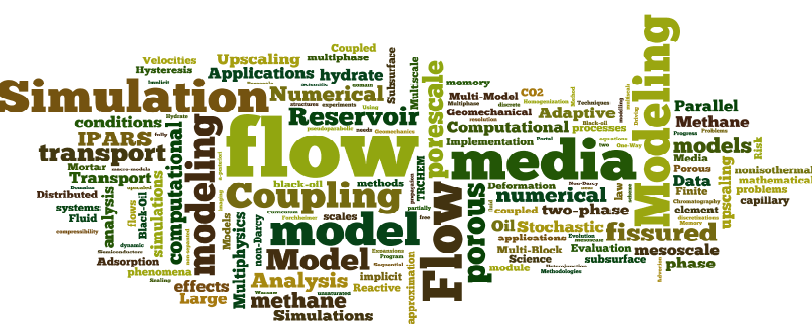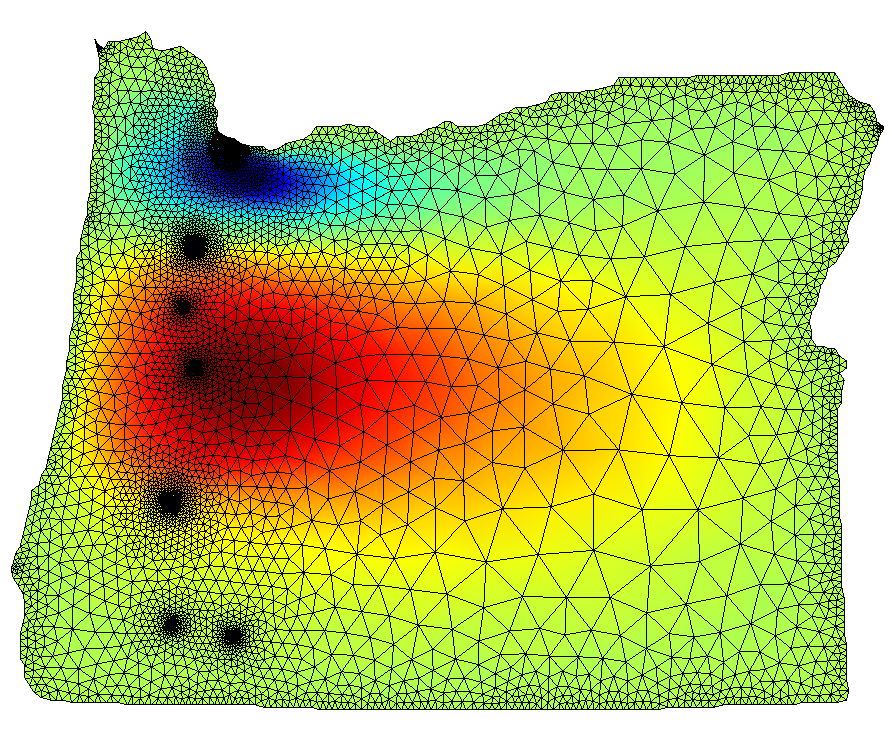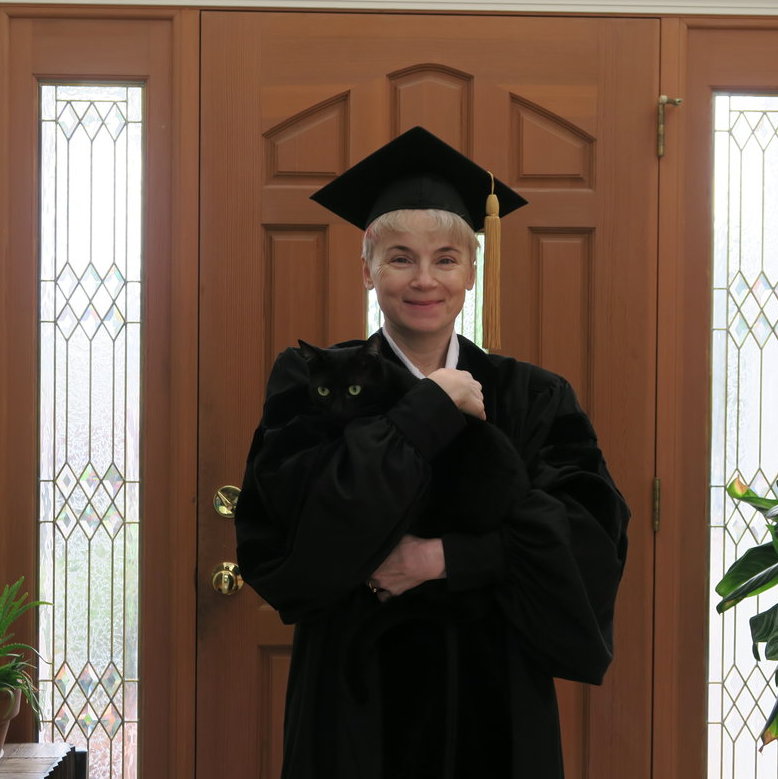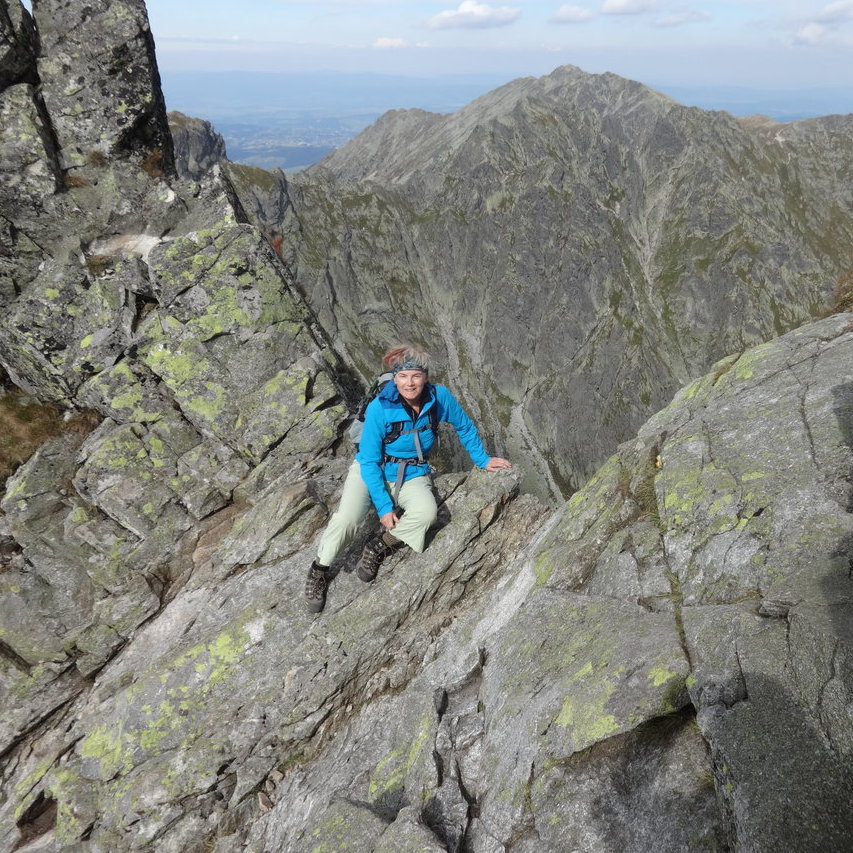Gallery of projects
Below we provide an overview of the "what, why, and how" and in particular a broader scientific context for our projects. We start with simple concepts and build up to complex ones. We try to keep the language non-technical, and we use images to convey the main ideas. The mathematical and technical details are in the publications. Please see projects for a summary listing, also with the references to the funding that helped to support our research. Even though the funding for some of the projects has expired, we continue doing research and publishing. The projects have been grouped by the specific challenge, methods used, or by the application area. Our projects have multiple entry points, so please contact me if you are interested in collaboration.
Credits
The images below come from joint work wth our collaborators and students. It takes us a lot of effort (and joy) to build the models, carry out their simulations, and prepare the images and movies. Please cite us if you would like to use them for your purposes. Thanks!
(We ask that you respect the Creative Commons CC BY-NC-ND 4.0 Attribution-NonCommercial-NoDerivatives 4.0 International license).
Flow & transport modeling
Flow and transport that we consider (here) is described by the traditional PDEs. Flow models are typically elliptic or parabolic, and transport models describe advection, diffusion, and reaction. Computational methods should be conservative, and higher accurate transport methods can help to prevent the smearing of the fronts. In complex geometries, the trick is to make sure that you have a conservative velocity field.
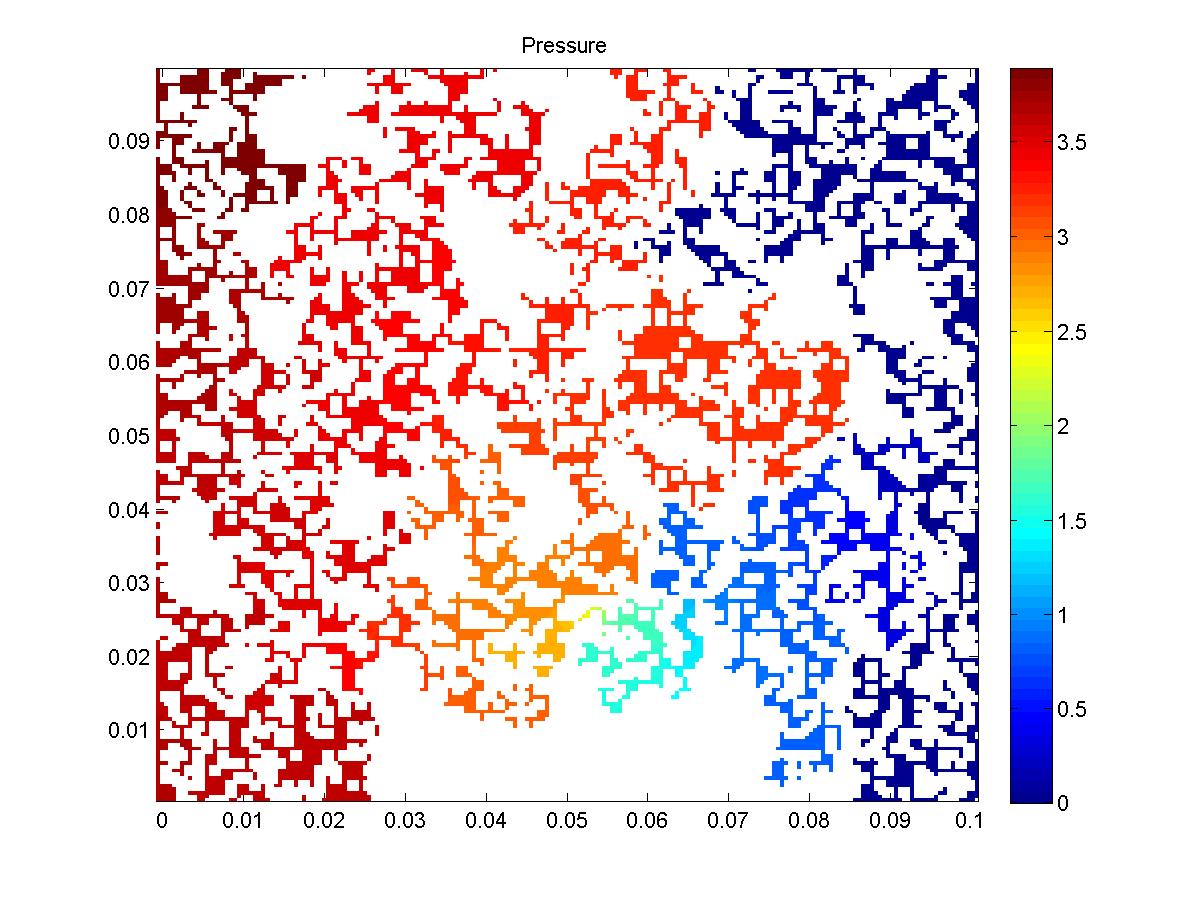
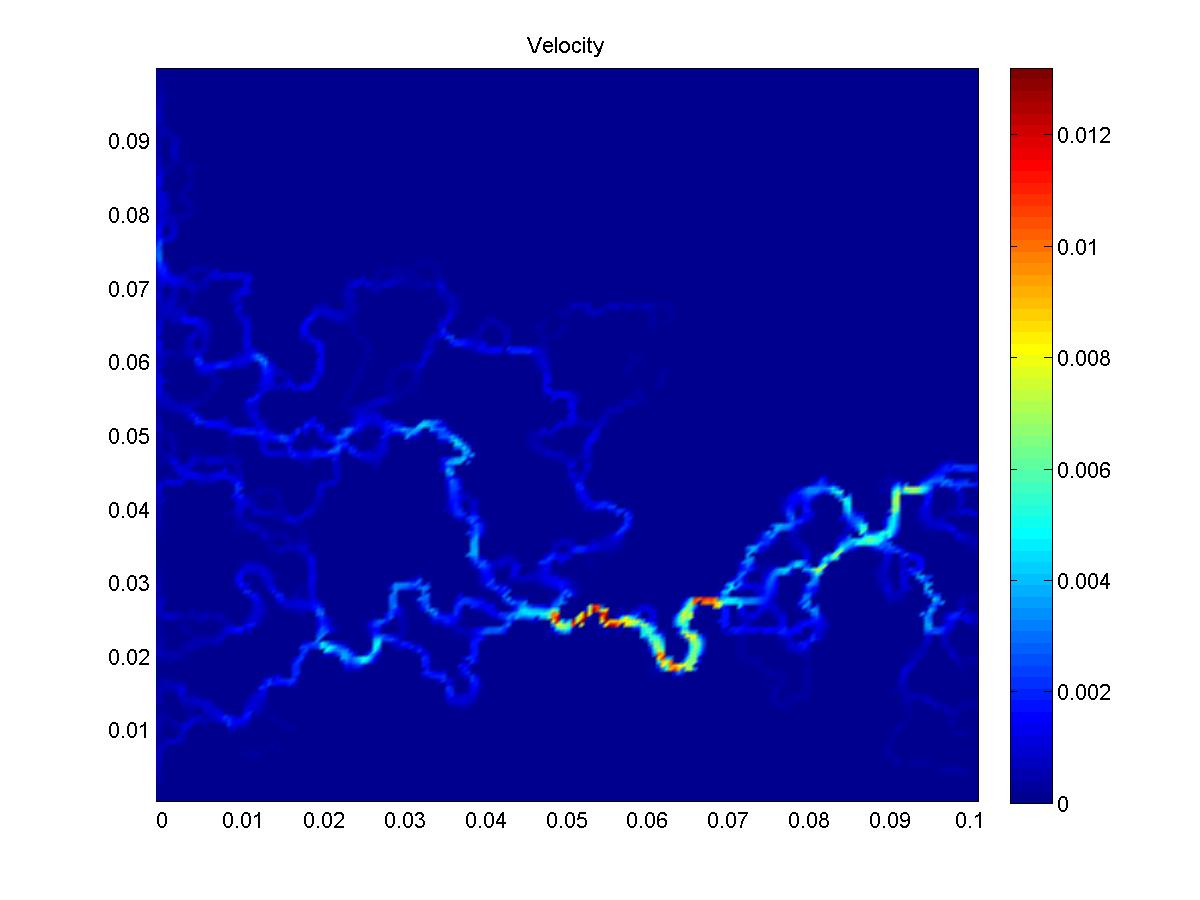
Pressure (left) and velocity field (middle) in complex geometry
(actually, at the porescale, but this is not relevant here). Right:
transport simulation in a similar geometry.
See also some flow and transport simulations at
the porescale.
Permafrost modeling: [TpHM] (Thermal with phase change, Hydrological, Mechanical)
Permafrost is "ground that remains frozen for 2 years or more".
We are interested in modeling coupled processes in its active layer
(where the temperature does change indeed) due to the fluctuating
environmental conditions (such as ground surface temperature).
From computational mathematics point of view, the model for "Thermal
processes with phase change" alone presents many exciting challenges
due to the ice-water phase transitions. In particular, we model the presence of free boundary between liquid and solid in the water component at the interface and pore-scale, and we model phenomena also at the Darcy scale.
A really good overview/introduction is here.
The peper #80 connects the pore- and Darcy scales. The supplement shows simulations of Stefan problem including the heterogeneous case at the pore-scale, and at the Darcy scale.
For more, see our results in papers #77, #79-80, #82-83, #85-87.
Multiscale modeling, analysis and simulation
One of the compelling examples of why we the multiple scales are important and challenging comes from the models and applications of flow and transport in porous materials. Our DOE multiscale grant involved modeling of preferential flow from meso- to macro-scale, and modeling from porescale to meso- scale. We first discuss the meso- to macro-scale problem. It is important when building large scale models (on the aquifer or hydrocarbon reservoir scale of kilometers) using coefficients measured in a laboratory from core samples, i.e., at the centimeter or meter scale.
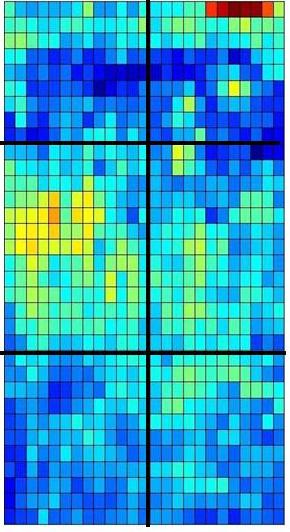
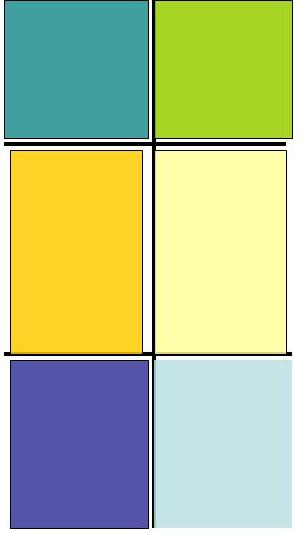
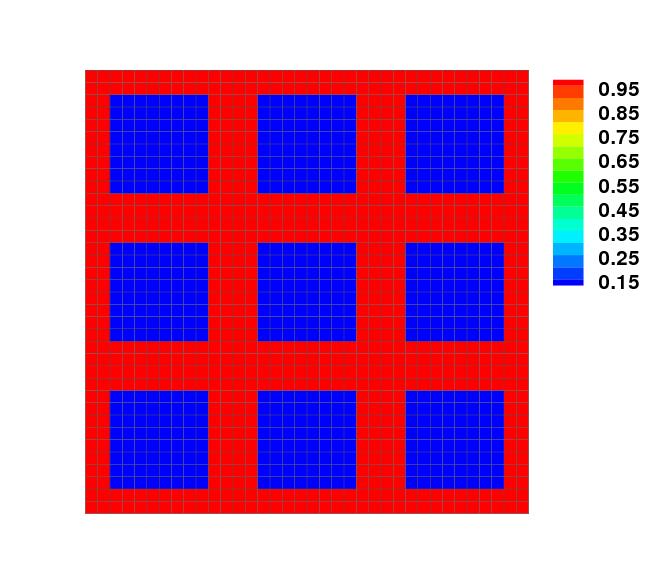
The "traditional" challenges in porous media were associated with heterogeneous and fractured (fissured) media. The difficulty is that the properties of the porous blocks in the matrix are very different from those of surrounding fractures, thus majority of flow and transport happens in the latter, while the storage is confined to the former. While one could, in principle, use very fine computational grids to resolve these fine details, this is not practical. Left pictures show the original and the upscaled permeability field. On the right we see an idealized "binary" medium: periodic fractured medium. Rather than attempt to solve problems at the fine scale, mathematicians have built upscaled models that work at the coarse scale, while incorporating the effects of lower scales.
Interesting things happen when you move to time-dependent and/or nonlinear models. The latter (with CG), e.g., for non-Darcy flow, can produce approximate upscaled models where you fit an effective model to some plausible algebraic form. In turn, the time-dependent case is quite interesting, especially if it comes from a coupled flow-transport model. With SY and RES we studied the case when the scales (contrast) are not well separated, and developed multiscale models with memory effects, represented by Volterra integrals with (weakly) singular kernels.
Now, even more interesting is the case when the model at lower (micro) scale is different than the one at higher (macro) scale. Such is the case of pore-2-core upscaling, when the lower scale flow models recognize the different physics (viscous flow-Navier-Stokes) from the upper scale (filtration laws such as Darcy's law). This case is part of our porescale modeling efforts and non-Darcy work. Things get even more interesting when the physics at different scales is completely different such as in the semiconductor project, where we used Density Fuinctional theory to calculate the properties of an interface handled by a jump condition in a continuum scale drift-diffusion (PDE) model. More broadly, this is why we started working on hybrid models which is what you need to put together model components of completely different types (such as centaur= body of a horse, and head of a human).
Non-Darcy flow and inertia effects
In the flow through porous medium, there is significant interaction of fluids with the surrounding rock grains, causing additional dissipation of energy (in addition to the internal friction). While at the porescale one still models the flow using Navier-Stokes or Stokes equations, the average flow satisfies non-Darcy's or Darcy's law; i.e. the momentum conservation equation. One interesting perspective is that the linear Darcy's law was discovered empirically with coefficients derived experimentally, and there is beautiful mathematical proof by homogenization (going back to the work of Tartar from 1980) that shows how Stokes equation can be averaged (in periodic geometries) to give Darcy's law.

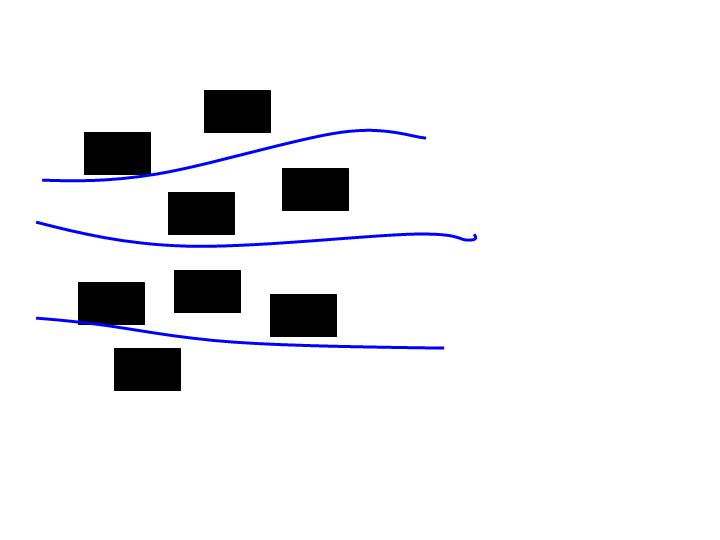
The cartoons illustrate the difference between viscous flow for high and low flow rates. At large flow rates, the flow paths tend to be more "straight", while at low rates they tend to be more "tortuous". For fluids in a river, ocean, or atmosphere, the PDE models of Navier-Stokes include the nonlinear advective term also called "inertia term". This term is dropped in the Stokes model which works well for low flow rates.
However, there is really not one universally agreed form of non-Darcy model, even though there have been attempts to generalize the 1d quadratic Forchheimer law to multiple dimensions and heterogeneous media. In our work we set out to use numerical averaging (homogenization or upscaling) to discover a general non-Darcy's law in our virtual laboratory. (See our porescale work and [PTrykozkoAugustson'2009, PTrykozkoKennedy'2010, and our other work joint with Dr A Trykozko '2010-; see also [GaribottiP'09 for upscaling non-Darcy flow].
Porescale modeling
Porescale modeling was once thought to be impossible, but is now very well developed. See Porescale Benchmark project, which evolved to Digital Rocks portal.
The first challenge in porescale modeling is to define WHY you want to do it. WHAT needs to be done is fairly obvious: you simulate the physical processes, and voila! Out come the simulation results (a lot of them). The WHY tells you what you can do with them, and the HOW is non-trivial.
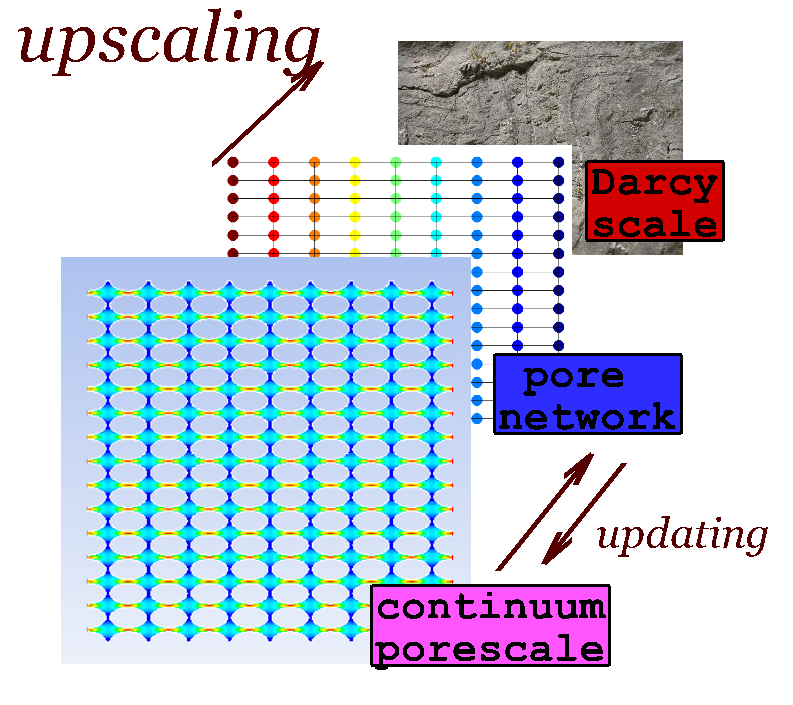
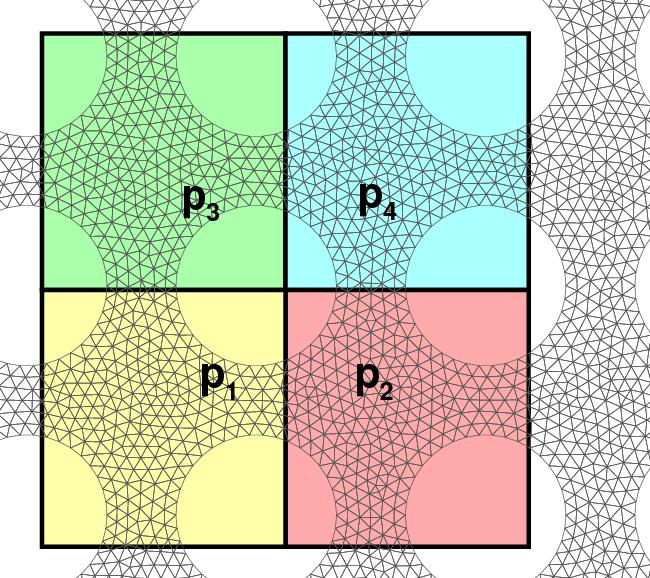
The image shows a heterogeneous porous rock (Darcy scale), which can be idealized as having periodic porescale geometry such as that shown in the background. At Darcy scale one solves a flow problem (e.g, an elliptic or parabolic PDE for the pressure). At pore-scale we solve the Stokes problem. One can next "upscale" from the Stokes scale to Darcy scale over a representative relementary volume using the setup such as shown on the right.
In particular, you need to consider methods of upscaling which will apply to nonlinear processes and non-periodic geometries, because otherwise you will always be stuck in an idealized-limbo about which almost all is known but from which it is difficult to move forward. You can use the linear periodic case for testing, but that's it.
In our first approaches, we approached high flow-rate (velocity) flow at porescale which is simulated with Navier-Stokes equations. When upscaling, this gives the collection of non-Darcy models, and, interestingly, there is no agreement to what they should be, especially if you want to consider anisotropy. We defined our own variant of upscaling via volume averaging, and (with KA and AT), were able to also identify appropriate anisotropic extensions of Forchheimer laws.
Then our appetite and curiosity grew. We wondered how much our findings depended on the "nice-ness" of the geometries. Hence, we started using real porescale data (sandstone, glass beads, tuff). Several colleagues shared with us their porescale micro-CT and Xray tomography data. The real fun started when the porescale was changing due to the presence of biofilm growing there, and eventually clogging some pathways.
The first movie (HS) was made using sandstone data from Brent Lindquist's group. The second movie (GB) was made using glass beads data from Dorthe Wildenschild's group. When we say "data" here, we mean we obtained the binary voxel data (e.g., 30M cells marked either as solids or as void). Then we applied fluid flow models. Visualization was done with Tecplot, and simulations with ANSYS Fluent. Watch out, there is music there to reflect our enthusiasm for the topic!
We continue efforts on modeling the flow at porescale when the geometry is changing, e.g, due to reactive transport, or phase transitions. For our first models, see [PTISW15] paper, and/or [TC] thesis, and/or [CKP18] paper.
The next example was made by Joe Umhoefer supported by NSF (DMS-1738014 and DMS-1522734), and it shows Eulerian and Lagrangian transport of particles at porescale, in a velociy field calculated by the software HybGe-Flow3D. See detailed description in "credits" to this movie, summarized below.
Eulerian and Lagrangian advective transport through a porous media shown on the left. On the right, we give the breakthrough curves for both, showing the solute output relative to the influx on the vertical axis, and time on the horizontal axis. Breakthrough curves for Eulerian transport in black, Lagrangian transport in red. Flow solution from HybGe-Flow3D (https://github.com/numsol/HybGe-Flow3D). Geometry Sourced from: [PTISW'16].
Methane hydrate: applications and math
To learn about methane (gas) hydrate, visit DOE-NETL hydrates page, USGS site , ORNL page .
I was fortunate to have been introduced to hydrate research by two colleagues from CEOAS, OSU, Marta Torres and Anne Trehu; see "Solving the world's real-life math problems" (December 2014 feature) on this collaboration. One of the challenges of hydrate modeling is that very few mathematical results were ever published on the topic prior to our work. Perfect for us! However, to understand the models first, we had to wade through the geochemistry and geophysics vocabulary, which is disparate from mathematical language. (They are similar but then they are not, like Spanish and Portuguese).
This video is a result of the first model we built. It is fully coupled, but we use the assumption of fixed and linearly varying pressure and temperature. Each graph is set-up in the way the geophysics community displays subsurface (horizontal axis is the variable, and the vertical axis shows the depth, which is quite natural when you get used to it). Details of this model are presented in the ICCS paper.
Since these initial models I worked with other collaborators and students on the hydrates. Our results include simulations, and analysis, with continued numerical analysis.
Mathematical framework we developed involves abstract evolution equations and complementarity constraints. These help to describe the so-called maximum solubility constraints which keep the amount of dissolved gas in the liquid phase from exceeding the bound imposed by thermodynamics. The hydrate (or free gas) form when the amount of gas exceeds the bound. Hydrate does not move, but free gas does, and there are still many mysteries involving the dynamics of this coupled system.
Our first approach was to study the entire system, see the movie from ICSS. Then we gradually disassembled the problem into smaller parts which we could analyze, as in the papers [GMPS'14, PSW'15]. Working from these most simple models towards more complex ones, we built in the coupling with the transport of salt, and the dependence of thermodynamics on the alt; see [PHTK'16] and [PMHT'16] which show how we solve the coupled system, and how our case study simulations compare with data from Ulleung Basin.
This video is my 2d
simulation inspired by the 1d case study and model from the paper
[DaigleDugan'2010]. The model accounts for the dependence of
thermodynamic constraints on hydrate formation on the type of host
rock in which it forms. We used our 2d "crucial enhanced"
implementation of the reduced numerical model we described in
[PHTK'16], enhanced by solving the pressure equation, and accounting
for the formation of fractures based on the pressure threshold
condition. The structure of coupled model is schematically depicted in the cartoons below.
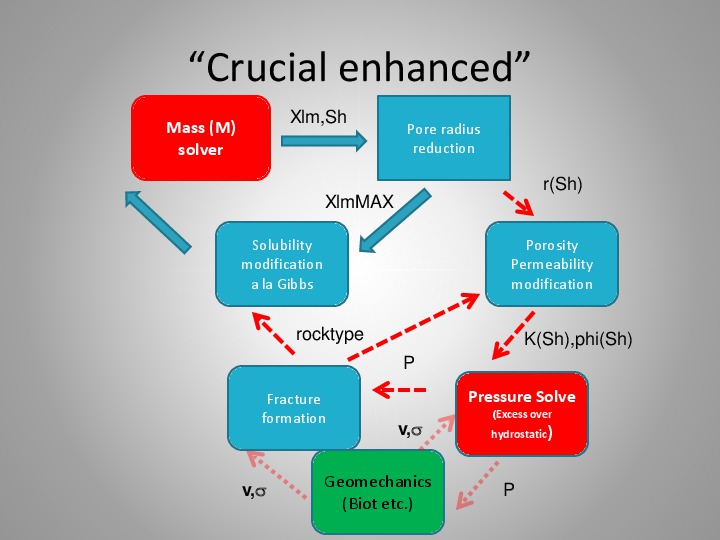
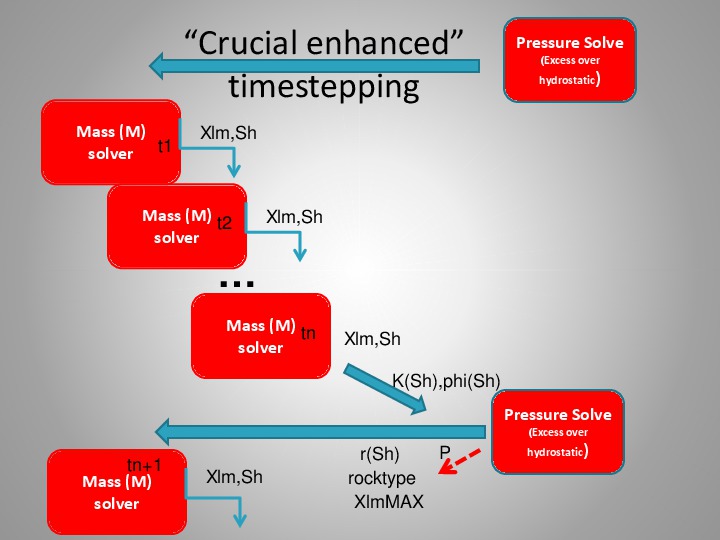 The geometry of the reservoir is inspired by that of
Hydrate
Ridge so that its top (in the middle) is higher than the sides. In
the simulation, the red-to-yellow (hot colors) show the increase of
methane hydrate saturation (Sh) caused by the migration of methane
upwards from the bottom of the reservoir into the hydrate zone. The
blue lines delineate rock types: initially, they differentiate between
fine-grained (clay) and coarse-grained (silt) sediment. Over time the
fractures form at the bottom which is shown as new rock type. The mild
nonsymmetry is a visualization artifact, but the uneven migration and
hydrate formation patterns are primarily due to the heterogeneity of
the rock. The time scale is in [ky]! Gravity points downwards, and the
top of the reservoir is the bottom of the ocean.
The geometry of the reservoir is inspired by that of
Hydrate
Ridge so that its top (in the middle) is higher than the sides. In
the simulation, the red-to-yellow (hot colors) show the increase of
methane hydrate saturation (Sh) caused by the migration of methane
upwards from the bottom of the reservoir into the hydrate zone. The
blue lines delineate rock types: initially, they differentiate between
fine-grained (clay) and coarse-grained (silt) sediment. Over time the
fractures form at the bottom which is shown as new rock type. The mild
nonsymmetry is a visualization artifact, but the uneven migration and
hydrate formation patterns are primarily due to the heterogeneity of
the rock. The time scale is in [ky]! Gravity points downwards, and the
top of the reservoir is the bottom of the ocean.
Our current work involves modeling hydrate formation at porescale to understand how it clogs the porescale. In particular, we are working on phase-field models. (More informaiton forthcoming). See also hybrid models.
Adsorption: classical and hybrid models
"Adsorption is a process in which the molecules of adsorbate form a film on the surface of adsorbent".The videos explain the process, and how an equilibirum forms between the average amount adsorbed and the average amount present in the fluid. The second video shows the idea that in some geometries, a nonequilibrium can form due to nonequal access to the surface, and this would result in hysteresis. The third video (made by F.P.Medina) is a cartoon of the process of competitive adsorption involving multiple components.
One particularly important application of adsorption arises in the study of methane gas which occurs naturally in the subsurface reservoirs, e.g., in coalbeds (or shales). Enhanced coalbed methane recovery techniques attempt to recover methane by injecting other gases such as carbon dioxide.
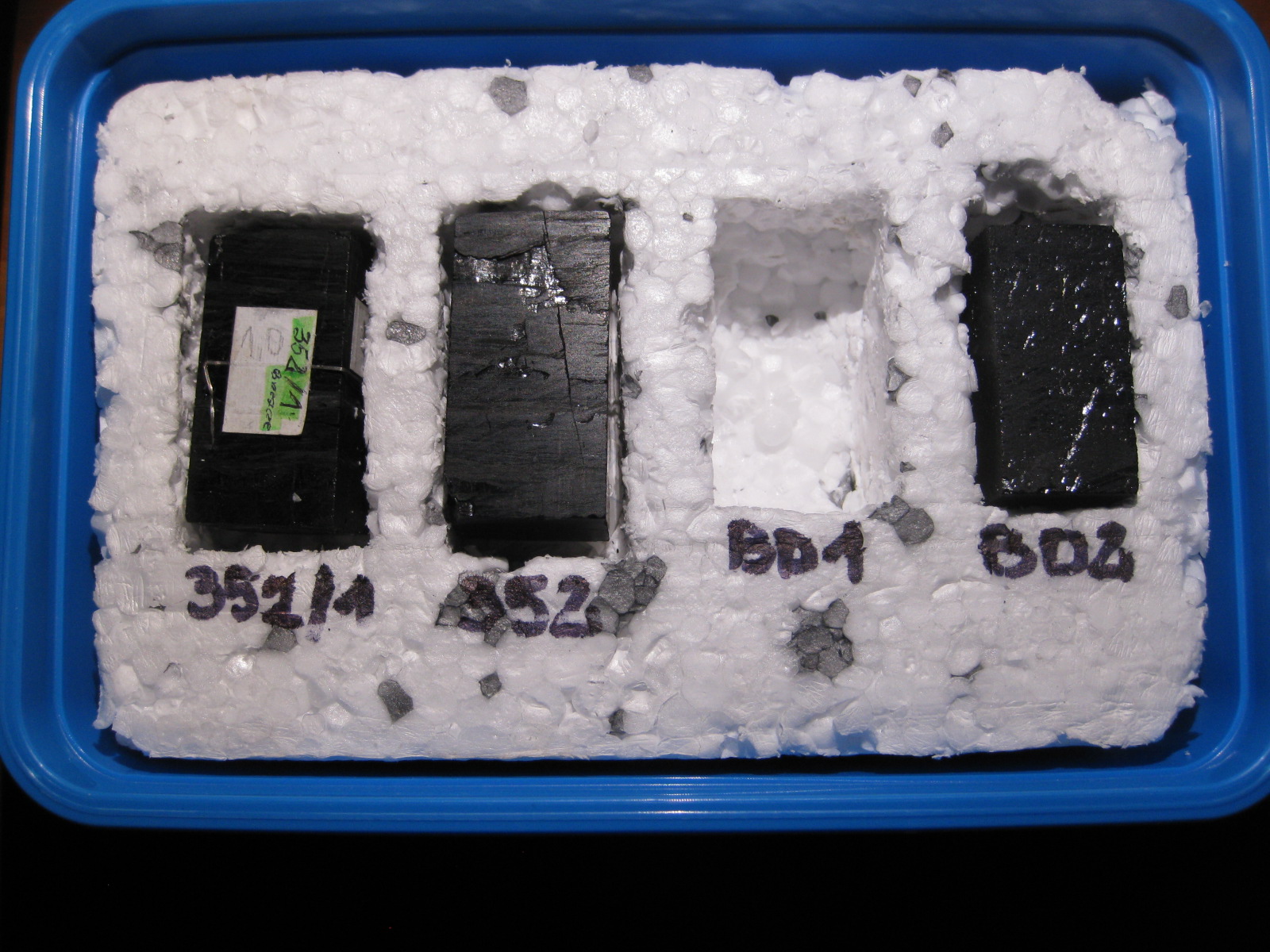
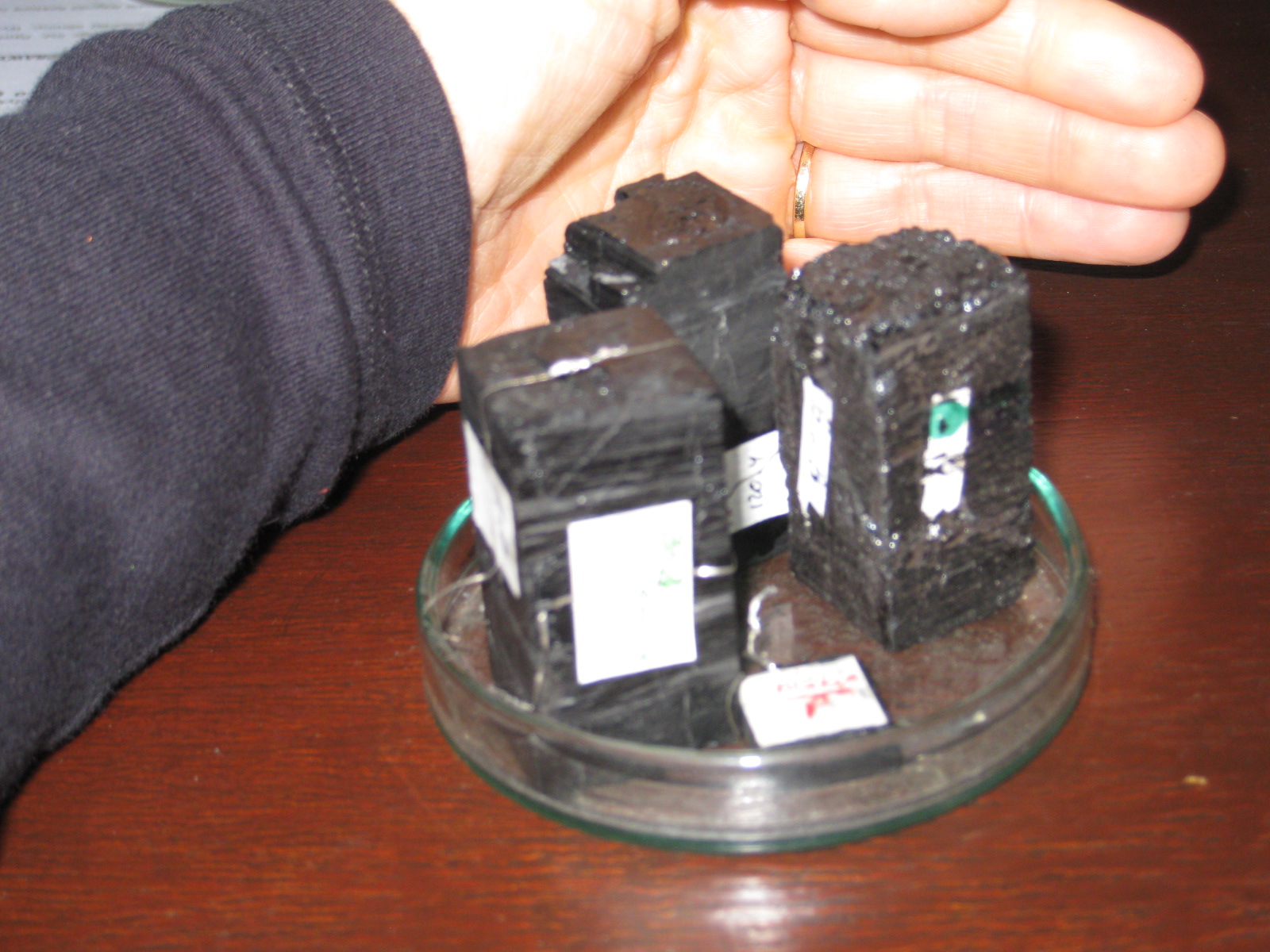
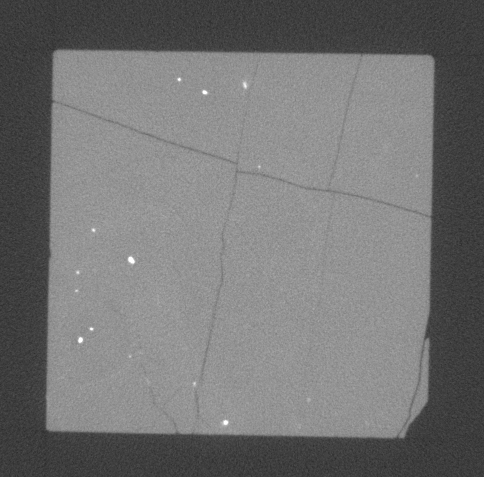

The images show samples of coal obtained from the lab at the University of Mining and Metallurgy in Cracow while I was on sabbatical as a Fulbright Fellow. The right image is a tomographic image of these samples which shows a "perfect" double-porosity structure of coal with fractures (cleats) crossing the matrix. The right-most image shows again the multiscale structure of coal. Since it involves (subscale) diffusion into the matrix, it causes memory effects.
Memory effects from non-equilibrium and subscale processes
Oh, the multiple scales. Sometimes the coefficients of a PDE model
vary significantly in space. For example, such is the case of porous
medium with fractures, where the permeability values in fractures may
be 1000 larger than those in the remaining (bulk=matrix) part of the
medium. At the same time, the fractures take up significantly less
volume than the matrix. Another example is of composite engineered
materials where, by design, one puts together materials with different
properties (softness, hardiness) so as to achieve optimal overall
performance. One can use homogenization (a rigorous and sophisticated
version of averaging) to infer effective properties of such media at a
higher scale.
Another example is that of viscous flow at
the pore-scale described by the Stokes flow,
which, after averaging, gives Darcy's law.
The memory effects arise when considering transient
phenomena in multi-scale media such as flow and transport. The
(slightly compressible) flow and/or diffusive transport in the two
parts of the medium (of large and small permeability) occur at
different time scales (fast and slow, respectively). However, the
"slow" parts cannot be ignored since majority of the fluid resides
there, and subsequently "feeds" the "fast" parts. In order not to have
to adjust the spatial and time discretiation to both media at the same
time, the idea is to use homogenization, and to include the "slow
parts" as subgrid effects or "memory effects".
Another example is the transport of gas in coal matrix with
adsorption.
In our work we studied the effects of such "memory effects" on the
solutions to the PDEs, and proposed and analyzed efficient numerical
schemes for these. In particular, see [P'2014, KleinP'2012], and work
with S.-Y.Yi and R. Showalter'2008-2014]. Our earlier work includes
that in [P'92-96]. The effect of memory effects on (nonlinear)
conservation laws was studied, e.g, in [P'13].
Analysis of well-posedness and of properties of solutions
After one takes an introductory class on Partial Differential
Equations (PDEs), everything is clear. Every PDE is of one of the
canonical types, the boundary conditions are always homogeneous, and
the data is always smmooth. Right? Thus, the classical solutions can be
proved to exist and be unique. (So these PDEs are well-posed).
Well, it ain't exactly so in real-life. Most real-life PDE models
studied today are nonlinear and coupled, and have nonsmooth
coefficients. The well-posedness defines which data gives rises to a
weaker notion of solutions, and how strict the assumptions on data
need to be to get uniqueness, and how large the class of solutions
needs to be to ensure existence of solutions. Of interest is also
sensitivity of solutions to the data.
In our work we have contributed to the analysis of solutions to
various real-life problems. The goal was to understand the structure
of solutions so that they can be (later) approximated numerically, but
many times the analysis itself was the point in itself. For example,
there is no point in using a method (such as finite difference) which
requires C4 smoothness, if your solutions are barely
C0! Or, if you supply more boundary conditions than needed
for well-posedness, no matter how fast your numerical method is,
it will fail. As another example, in the process of studying
the stability of solutions to the continuous model, one discovers
whether stability can be expected from the numerical
solutions. Finally, we also studied properties of solutions in the
presence of interfaces, and the dependence of solutions on various coefficients.
Numerical analysis of flow and transport processes
Most models of real-life phenomena do not have closed form solutions. For example, in general, you cannot solve exactly polynomial equations of high order, or calculate integrals with some monstrously complex integrands, or solve high-order non-separable differential equations not amenable to some magic substitution.
However, one can approximate such solutions. Numerical Analysis is the study of algorithms for the approximations, and Scientific Computing is the field devoted to the most efficient computer implementation of the algorithms. Numerical Analysis assesses the error in approximation, and specifies under what assumptions the error converges to zero. It also suggests how to determine whether such an approximation is "good enough", for example by studying a-posteriori error estimates that help to determine whether to continue some iteration, or mesh refinement. In our work, we have mostly considered numerical analysis for flow and transport problems. We derived a-priori and a-posteriori estimates for the approximations derived with Finite Element methods (Galerkin amd mixed methods), using domain decomposition and mortar couplings. We also considered stability in time and derived various conditions for (advective) transport dominated problems and problems with memory terms. We were also involved in HPC (High Performance Computing) projects (see [P et al 1998-2005]) in which methods proven stable and accurate for simpler problems were implemented, tested, and used for simulations of complex coupled multiphase multicomponent systems; see e.g. our hydrate projects.Coupled nonlinear phenomena
Analysis and numerical analysis of scalar (differential) equations (when we solve for only one unknown) is fairly well developed. Coupled phenomena such as flow & geomechanics, or flow & transport, require that we solve for several unknowns which appear in several equations. The first common difficulty is that the coupled system has a structure that does not have a familiar structure, say of elliptic or parabolic type. Moreover, the coefficients of the coupled system frequently depend on other uknowns, can degenerate (go to 0) or get singular (blow up), thereby changing the type or the expected qualitative properties of the solutions. A particular class of coupled systems is in the modeling of multiphase multicomponent flow and transport such as in groundwater contamination scenarios or oil and gas recovery reservoir simulation. Another important class is of (very nonlinear) coupled system modeling interface evolution in phase transition models such as the Cahn-Allen and Cahn-Hilliard equations.
Important keywords: solvers, multiphysics, multinumerics.Hysteresis and monotone operators
Simply put, hysteresis occurs when the output depends on whether the
input is increasing or decreasing. This means that there are
multiple outputs corresponding to each input, i.e., a relationship
with hysteresis is not a function.
The graphs show a hysteresis operator with a piecewise linear
output, and the corresponding movies show the evolution. There
are multiple outputs w corresponding to a particular input, e.g,
u=3. The value w depends on whether the input u(t) is increasing
in time t or decreasing (see arrows and the movie).
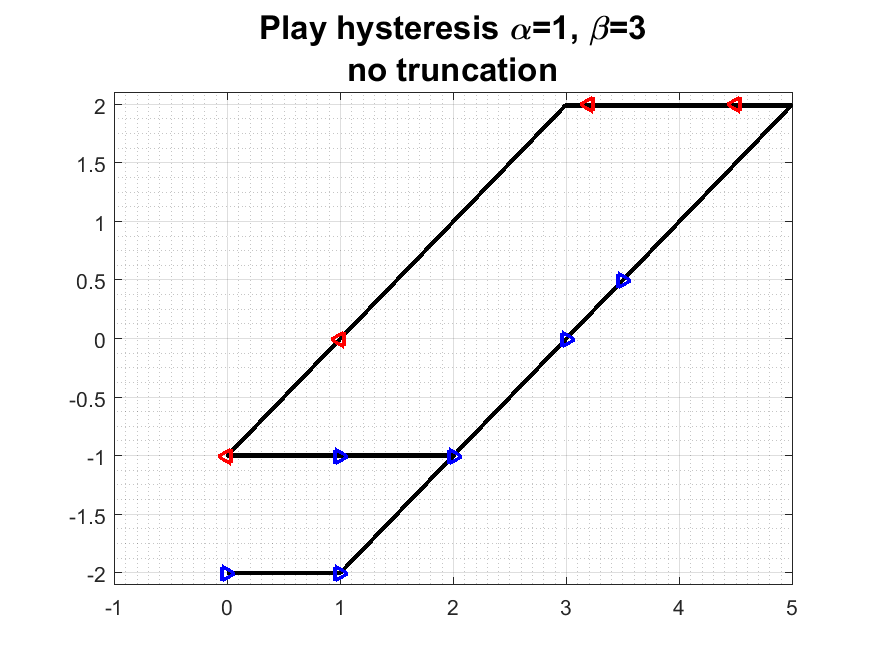
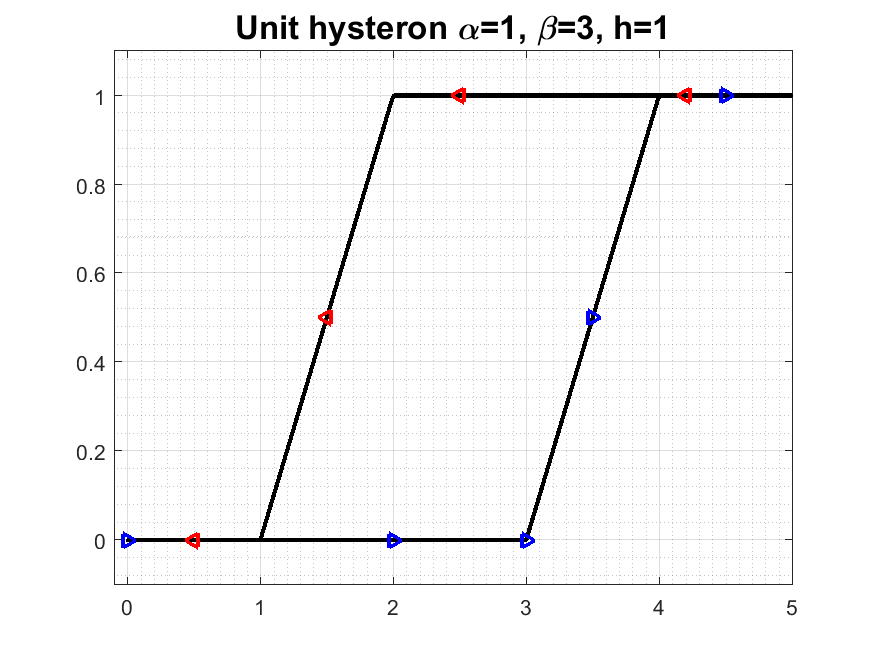
The first movie/graph show the simple "play hysteresis". In each frame
of the movie, on the right, you see the input u(t), together with
the corresponding w(t) which is "dragged" by u(t). On the left you
see the phase portait of the graph in (u,w) plane. A linear
combination of "play hysterons" was the model we analyzed in
[PS97].
The second movie/graph show what we call the "unit hysteron", which
takes the same input as the play example, but the output is
truncated.
Models of hysteresis are challenging, because they require extension
of a notion of a function to a (multivalued) operator or graph. This
makes the analysis of, and approximation to the solutions to models
which involve hysteresis, exciting enough!
A very useful but also very complex construction of hysteresis
operators follows the notion of Preisach hysteresis. We have
developed another class of models based on a simple construction of
an ordinary differential equation under a constraint. In [PS97] we
analyzed the solutions to a transport model with a particular
convex-concave hysteresis operator; the crucial observation was that
thanks to the convex-concave character of the graph, the solution
was more rgular than in the usual C^0(L^1)setting; in particular, it
was continuous.
Recently (see forthcomng paper [PS18]), we have extended the hysteresis models to include realistic graphs such as the adsorption/desorption hysteresis graph. This is achieved with the help of a truncation functional which helps to isolate individual portions of the graph. However, due to the additional nonlinearity in the construction, the solutions can only be analyzed in the C^0(L^1) setting on a product space. The added benefit is the ability to calibrate any reasonable experimental graph with a simple adaptive procedure.
Random or unknown data, uncertainty, and stochastic simulations
Forthcoming ...
Hybrid modeling
Broad description forthcoming ...
The simulations show how you can use a version of Metropolis algorithm to find an equilibrium configuration of fluid (red) in the presence of porous medium (black squares). here the preference to aggregate and to adsorb are controled by the proportion of parameters wff and wmf.
Other projects ...
Work in progress!
